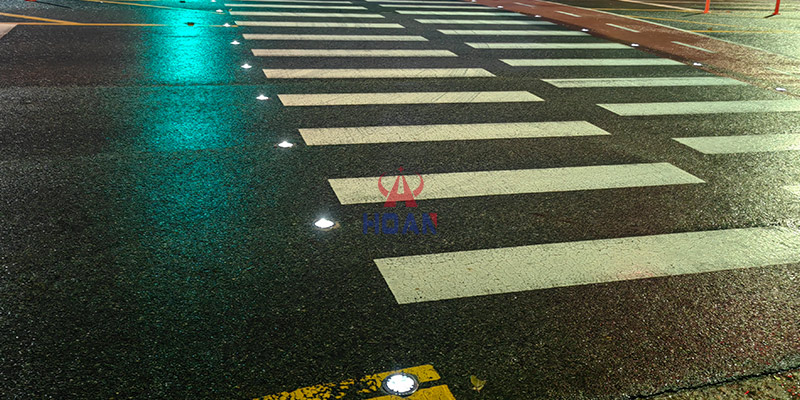Nighttime and low-visibility conditions (such as rain, fog, and snow) significantly increase the risk of road accidents. Traditional road markings and reflective studs often fail to provide sufficient visibility because they rely on the reflection of vehicle headlights — a method that becomes completely ineffective in adverse weather conditions or on unlit roads.
According to data from the World Road Association, over 40% of fatal road accidents occur at night, despite lower traffic volumes compared to daytime. One key reason is the poor visibility of road boundaries, lane divisions, and potential hazards.
Solar road studs address these challenges by combining self-powered energy with active lighting. Unlike passive reflective studs, they generate their own light, ensuring consistent visibility under any external conditions.
Traditional reflective road studs only function when illuminated by vehicle headlights, and their visibility drops sharply in fog or heavy rain. However, solar-powered road studs use high-brightness LEDs powered by solar energy for active illumination. This self-generated light can penetrate darkness and adverse weather conditions, with a visibility range of up to 800 metres — three times that of reflective road studs.
Solar-powered road studs are specifically designed to withstand harsh conditions:
Waterproof: IP68 protection rating, capable of withstanding submersion in water, making them ideal for flood-prone areas.
Temperature-resistant: Operates efficiently within a temperature range of -40°C to 70°C, adapting to various climates such as polar regions and deserts.
Fog penetration: Its focused LED beam can penetrate fog, ensuring visibility even when traditional markers fail.

Solar road studs collect solar energy through integrated solar panels and store it in long-lasting lithium-ion batteries. This eliminates the need for wiring or grid connections, making them ideal for remote areas, rural roads, or temporary construction sites with limited power access.
By using renewable solar energy, they reduce reliance on fossil fuels, with each road stud reducing carbon emissions by approximately 1.2 kilograms per year. Unlike grid-powered lighting, they incur no electricity costs and have low maintenance requirements (with a lifespan of 5–7 years), minimising long-term costs.
Solar road studs clearly mark lane edges, curves, and intersections, reducing lane departure accidents — the primary cause of nighttime collisions. In highway tests, roads equipped with solar road studs saw a 35% reduction in lane-related accidents.
In urban areas, solar road studs illuminate pedestrian crossings, cycle lanes, and school zones, making pedestrians and cyclists more visible to drivers. A study in London showed that pedestrian crossings with solar road studs saw a 58% reduction in incidents after dark.
Installing solar road studs does not require digging cables or electrical work. They are secured to the road surface using strong adhesive or screws, with each unit taking only a few minutes to install. This makes them ideal for quick upgrades to existing roads or emergency areas such as accident sites.
Solar road studs are highly durable:
Their batteries can maintain power for 7–10 days without sunlight, ensuring normal operation even during consecutive cloudy days.
High-strength ABS or aluminium alloy casings can withstand heavy traffic (including trucks and buses) with minimal wear and tear.
The self-diagnostic function of high-end models alerts management to faults, reducing the workload of maintenance inspections.

On motorways, solar road studs enhance visibility at exit ramps and central dividers, reducing high-speed collision accidents. In rural areas, they replace missing streetlights, transforming unlit roads into safe, passable routes.
In cities, they mark intersections and bus lanes, alleviating traffic congestion. In construction zones, temporarily installed solar road studs warn drivers to slow down and divert, reducing risks to workers and pedestrians.
Solar road studs revolutionise road safety through active illumination, energy independence, durability, and cost-effectiveness. They address visibility challenges at night and in adverse weather conditions, protect all road users, and align with global sustainable development goals. Whether on bustling city streets or remote rural roads, solar road studs are a wise choice for enhancing road safety — that’s why we use them.
If you’d like to learn more about deploying solar road studs in your road projects, contact our expert team for customised solutions.